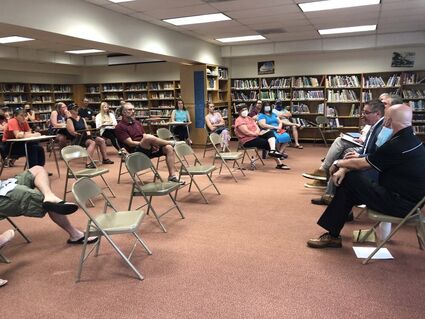Second School Forum delves into Special Education issues
June 24, 2021

-Chronicle photo by Melissa Gemmell
Concerned parents attended the second School Forum last week, hearing from administrators from the Educational Service District.
DAYTON–The School District hosted the second of four planned forums on June 17. The topic was special education. Contributors to the forum was Superintendent Guy Strot, Middle and High School Principal Kristina Brown and School Board Chair David Bailey.
Special guests were Education Service District (ESD) representatives Jeffrey Niece, who is the Executive Director of Special Education; Daniel Barnhart, who is a Behavior Specialist with ESD 112; as well as Emmy Kirk, who is the Assistant Special Education Director for ESD 123 and Special Education Director for Dayton Schools. They offered their input on the issues concerning Special Education in the Dayton School District and the plan going forward.
The recent concerns about the discipline in the schools have included issues surrounding special education. Students in special education have an Individualized Education Plan (IEP). Some of the students who have had altercations have an IEP and the State provides guidelines and limitations on how they are disciplined. Claims have come from staff that they are unequipped with tools, unsupported by the administration and are in unsafe situations working with students in both general and special education.

Fourth grade teacher Jessie Howard reported a lack of support from the ESD with multiple cancelled appointments when she was facing repeated infractions that ultimately led up to a student hitting her, giving her a black eye.
A parent of a student in Howard's class, Wendy Sabin, said her child "essentially watched her teacher be terrorized by a child." Barnhart, who is from ESD 112, said the supports, when in place and properly followed, "kids who formerly were terrorizing the school, now are practically model students."
Barnhart says that the Dayton district is being exposed to things that other districts in more metropolitan areas have been dealing with for years and have sort of gotten ahead of. "We have to teach these kids what we expect from them because especially if they are impacted developmentally, or neurologically, or in any way, it's on us to teach them how to respond," he continued. "It's long haul for some of these kids, and we need more resources for them, but when we see them be included and become accepted, they start to see themselves differently. And that's why important for all of us as a community to respond with empathy and compassion and education to how to do this and to do it appropriately. Not at the expense of anybody's physical safety or wellbeing, but for the health of the child."
Niece (ESD112) understands the difficulties rural Dayton faces because larger schools are already dealing the much of the same situations and have been for years. "I think we'll see more over the next year or two...more motivation for a systems approach rather than a removal approach or a suspension approach. Those have been gone for a while already."
Niece went on to explain the nine ESDs in the State of Washington are assigned to work with a group of several school districts as a "right arm" of the Office of the Public Superintendent (OSPI) for implementing initiatives and legislation. They partner with districts in ensuring a free appropriate public education (FAPE) is available for special education students as required by federal law.
The ESD, on the other hand, provides resources including professionals such as psychologists and takes on the burden of responsibility in regards to complaints which can work as a protection for districts from being sued.
"The way the laws are changing in which students are to be given opportunities to have interventions before they become on an IEP. We are like the 17th state in the United States to move towards doing something called a Multi-Tiered System of Support (MTSS) practice in which general education and special education will work together to serve students in a multitude of ways before you even start to look at qualifying them," he said.
Emmy Kirk (ESD112) went on to say that "The other big piece that the ESD offers is technical assistance. Special ed and special ed laws are really nuanced as is all of our reporting requirements to the State. It is an overwhelming amount of data and support that our professionals...afford to our teachers and to the districts so that we're maintaining those reporting requirements and taking that off of the districts."
Niece also spoke of the ESDs requirement to report to the State how they are following the federal law entitling special education students to be in the least restrictive environment (LRE) with their peers in general education the maximum amount of time possible.
Teachers have the ability to reach out to the EIP student's ESD case worker when having difficulty. Staff and parents have expressed concern that the ESD has not responded. Kirk said that the services are adjusted for each school after the previous school year has been evaluated and the level of services are adjusted based on need.
Special education teacher Tanya Patton offered her perception of the district and school administration and the representatives from the ESDs. "I believe with all my heart that the people who are sitting he, they really do care about kids and I have felt that the decisions and the supports I have had from them has been all about kids– what do those kids need and they have been there for me. I appreciate that very, very much."
The district will be working with the ESD representatives towards drafting an updated discipline policy. Additionally, staff will receive Right Response Training to learn skills in handling situations as they come up.
"There are systems in place that help general education teachers not cope, not get through a stressful moment but actually not get to the moment in which they might get hit," Niece said.
Another change is the special education teacher will be relocated from the district building to the main elementary building to be more integrative. Plans also include hiring a behavior specialist to provide equal support to staff and students. There has already been one applicant according to Strot.
The forum brought a bit more understanding and light of hope when it come to helping students and working with teachers to get through tough situations. "Our teachers and staff are responsible for maintaining a safe productive learning environment," expressed Sabin. "There are resources available to our district to help us meet this very specific, important goal."
There were about 30 attendees, mainly parents, several staff and school board candidates who all expressed an interest in the problems this school district faces.
The Dayton School Board appointed Jeff McCowen to the interim at-large vacant position left by Katie Leid during the meeting on June 16.
Several resignations were announced including Music and Band teacher Scott Sumner, and high school Business teacher Renee Slaybaugh. Previously announced was the resignation of high school English teacher Sarah Ortuno. Elementary teacher Susie Payne is retiring after 40 years. Strot reported the district hired Caitlin Patterson as a K-12 counselor. She comes from Blue Mountain Counseling.

